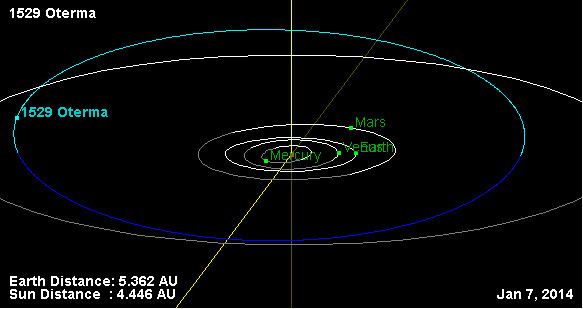Discovered by Y. Väisälä MPC designation 1529 Oterma Observation arc 66.38 yr (24,246 days) Aphelion 4.8 m Discoverer Yrjö Väisälä Discovery site Iso-Heikkilä Observatory | Discovery date 26 January 1938 Discovered 26 January 1938 Orbits Sun | |
 | ||
Alternative names 1938 BC · 1950 PV1959 RD1 · A912 VO | ||
1529 Oterma, provisional designation 1938 BC, is a reddish, rare-type Hildian asteroid from the outermost region of the asteroid belt, approximately 56 kilometers in diameter. It was discovered on 26 January 1938, by Finnish astronomer Yrjö Väisälä at Turku Observatory in Southwest Finland. It is named for Liisi Oterma.
Description
The carbonaceous body belongs to an exclusive group of 33 known asteroids with a spectral P-type in the Tholen classification scheme. It is a member of the Hilda family, a large group of asteroids that orbit in resonance with the gas giant Jupiter. Hildian asteroids are thought to have originated from the Kuiper belt in the outer Solar System.
It orbits the Sun at a distance of 3.2–4.8 AU once every 7 years and 12 months (2,915 days). Its orbit has an eccentricity of 0.20 and an inclination of 9° with respect to the ecliptic. Oterma was first identified as A912 VO at Winchester Observatory in 1912 (799). The body's observation arc begins at Turku a few weeks after its official discovery observation.
During a study of 47 Hilda asteroids in the 1990s, a rotational light-curve of Oterma was obtained from photometric observations at the Swedish Uppsala Astronomical Observatory and other places. It gave a rotation period of 15.75 hours with a change in brightness of 0.18 magnitude (U=2).
According to the space-based surveys carried out by NASA's Wide-field Infrared Survey Explorer with its subsequent NEOWISE mission and by the Japanese Akari satellite, Oterma measures 56.33 and 60.1 kilometers in diameter and its surface has an albedo of 0.054 and 0.047, respectively. The Collaborative Asteroid Lightcurve Link assumes a standard albedo for carbonaceous asteroids of 0.057 and calculates a diameter of 54.40 kilometers, using an absolute magnitude of 10.05.
Oterma was named for Liisi Oterma (1915–2001), first Finnish female astronomer with a Ph.D. and a discoverer of minor planets and comets at the Turku observatory between 1939 and 1953. Naming citation was published before November 1977 (M.P.C. 3929).
